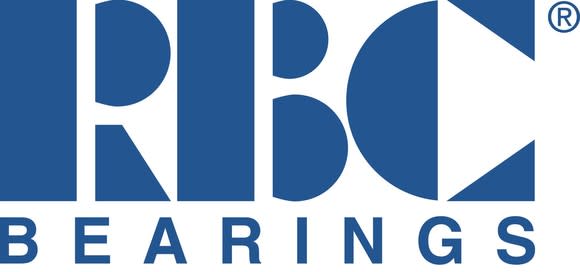Here's What Made RBC Bearings' Year
You don't have to make entire aircraft in order to benefit from the huge gains in demand in the aerospace industry. Even though plane makers tend to get a lot more attention, the parts and components that go into them play a key role, and RBC Bearings' (NASDAQ: ROLL) precision components and bearings are essential for its aerospace, defense, and industrial customers to reach their own production and sales goals. Now that it's getting more demand across its customer spectrum than it did in past years, RBC is optimistic that things will improve from here.
Coming into Wednesday's fiscal fourth-quarter financial report, RBC Bearings shareholders were expecting more growth in key financial metrics. The company didn't quite deliver everything that investors wanted to see, but its prospects going forward remain favorable, and bullish investors see a lot of promise from the precision crafter of components and bearings in support of a booming industry.

Image source: RBC Bearings.
How RBC Bearings finished its fiscal year
RBC Bearings' fiscal fourth-quarter results weren't perfect, but they still showed considerable strength. Revenue was higher by 12%, to $179.9 million, topping the 10% growth rate that most investors were expecting to see. Adjusted net income rose 22%, to $26.4 million, and that resulted in adjusted earnings of $1.08 per share. That figure wasn't quite as strong as the consensus forecast among those following the stock for $1.14 per share on the bottom line.
Looking more closely at RBC's fundamental performance, the company got a surprising boost from outside the aerospace arena. Net sales for aerospace were up a respectable 5% from year-earlier levels, but that paled in comparison to the 26% jump in sales to industrial-market customers. Trends from an organic standpoint similarly favored the industrial side of the business.
RBC's product lines showed consistent strength. Roller bearings kept up its winning streak with gains of 25% in sales compared to 16% in ball bearings and 13% in plain bearings. Engineered products saw growth slow but still managed to stay positive at 2%.
Yet some of RBC's performance wasn't positive. Gross margin fell by about seven-tenths of a percentage point, to 38.8%, and double-digit increases in overhead expenses stemmed from personnel-related expenses and a modest amount of stock-based incentive compensation. Even so, declines in internet expense and a huge drop of nearly 7 percentage points on RBC's tax rate had a nice impact on its bottom line.
What's next for RBC Bearings?
CEO Michael Hartnett liked the forward movement that RBC managed to build up during what he called "a tremendous year" for the company. "Most of our industrial and aerospace markets contributed to achieve strong organic growth," Hartnett said, "and free cash flow generation supported a net debt reduction of over $100 million over the year." The CEO seemed pleased with most aspects of the company's operations during fiscal 2018.
RBC's backlog figures seem to support the idea that good times could continue. The company said that its total backlog was up more than 10%, to $392.1 million, as of March 31. That gives RBC about two quarters' worth of prospective revenue.
Yet RBC's immediate guidance to start the new fiscal year didn't seem quite as upbeat. The company expects sales of $171 million to $174 million, which is less than the consensus forecast for $175 million. Expected growth rates of roughly 4% to 6% are modest, and some would like to see a bit more optimism to get fiscal 2019 off on the right foot.
RBC Bearings shareholders nevertheless stayed focused on the long run, getting past an opening decline to climb 1% in the first half-hour of trading following the announcement. With an opportunity to keep serving aerospace and industrial customers that are hungry for its products, RBC Bearings has the potential to see further gains in the immediate future.
More From The Motley Fool
Dan Caplinger has no position in any of the stocks mentioned. The Motley Fool has no position in any of the stocks mentioned. The Motley Fool has a disclosure policy.

 Yahoo Finance
Yahoo Finance 